|
(Precursor Experiment detecting only one electron in coincidence with
both heavy fragments.)
One of the central questions of today's atomic physics concerns the dynamic-electron-electron-correlation of many electron systems. Stationary many body systems are already examined in atomic physics successfully with high precision and are theoretically very well described. However dynamical multi-particle proc-esses are not understood very well today.
The simplest multi-electron systems represent the helium atom and the hydrogen molecule. One of the structurally simplest and most fundamental processes, which can disturb such systems, is the photo absorption. The photo absorption is described by a single body operator. For this reason two-electron processes, as for instance the single ionization plus excitation is or the double ionization is like and which are induced by interaction processes, always are a consequence of electron-electron correlation. In the case of the photo absorption energy, mo-mentum and angular momentum of the photon are consumed completely by the atom or molecule. The momentum of the photon is thereby small against the momenta of the emitted electrons. And its value is also tiny against the momenta of the recoiling ions from the coulomb explosion of the hydrogen molecule. De-termining the momentum of each particle by direct measurement or over conser-vation laws, one gets a detailed insight on the dynamics of such systems.
In our working group the dynamical processes in the case of the photo absorp-tion of the helium atom have been already investigated successfully within the last few years [ 1 ]. So that now in the next step the examination of simple molecules was the logical consequence. The investigation of the fragmentation of H2 or D2, induced by the absorption of one particular photon, represents an impor-tant connection between the photoionisation of simple atoms (as for instance the He atom is) and more complex molecules (like N2 or CO). The absorption of a photon with an energy over the double ionization threshold transforms the simple molecule into the complicated final state of a free four-particle coulomb system. The advantage of the fragmentation process of such simple molecular structures is situated in the fact that with these processes no disturbing rearranging proc-esses will occur, like it can be in case of more complex molecules. Thus by the photo double ionization of H2 or D2 two pure repulsive working coulomb poten-tials are present, which interaction can be studied in every detail with the help of the COLTRIMS technique applied here. Measuring the outgoing momentum vectors of the two running out cores in the final state of the reaction one can con-clude directly to the spatial orientation of the two centers of the molecule at the time of the photoabsorption.
In the measurements presented here quadruple coincidences (2 electrons and 2 recoil ions) could be realized. Thus it was possible to derive electron momentum distributions relative to the orientation of the molecular axis and to the polarization vector of the ionizing photon. And in addition it was possible to determine the momentum distribution in a center-of-mass system of the electrons, in which one electron is emitted with fixed energy and under a fixed angle in respect to the internuclear axis. Such completely differential cross-sections offer the most exact test of theoretical forecasts, which is possible. The existence of one preferenced direction by the molecules leads to a 1Sg+ symmetry in the initial state of the molecule. Also the existence of two symmetries in the electron wave functions of the final state 1Su+ and 1Pu, which play a role even for arbitrarily aligned mole-cules, have an influence on the structure of the momentum distribution of the fragments. For this reason informative differences between the fragmentation processes of atoms and molecules can be expected. Thus the electron angular distributions are of special interest (see figure 4 and 5). It was among other things the target, to determine Triple Differential Cross Sections (TDCS) for a fixed in space electron relative to the molecular axis. The intensity and the an-gular correlation can give explanation about the influence of rotation statuses and about possible interference effects of the molecule. The nodes in the distribu-tions, which can be expected, can give a hint of the importance of symmetries (b-Parameter) in the molecule in contrast to the observed helium atom [ 2 ].
References:
[ 1 ] R. Doerner et al., Phys. Rev. Lett. 77, (1996), P. 1024
[ 2 ] N. Scherer al., J. Phys. B: At. Mol. Opt. Phys. 31 (1998) L817-l82

Fig. 1: Electron and Recoil Ion Momentum Spectroscopy was used in order to image the photo double ionization of hydrogen (see figure above). The electrons and the ions were guided on position sensitive detectors applying an electrostatic and mag-netic field. In order to gain resolution for the electrons the electric extraction field for the ions was pulsed. From Time of Flight (TOF) and the position on the detectors the momentum vector of all four outgoing particles could be determined.

Fig. 2: Using a magnetic field in order to prevent electrons leaving the spectrometer, the electrons were spiraled up. These wiggles are a good tool to determine the mag-nitude of the magnetic field. At the same time they help calibrating the time of flight direction (see figure above). Measuring the outgoing momentum vectors of the two running out cores in the final state of the reaction one can conclude directly to the spatial orientation of the two centers of the molecule at the time of the photo absorp-tion. The momentum vectors of the two electrons represent the square of the wave function in the final state.
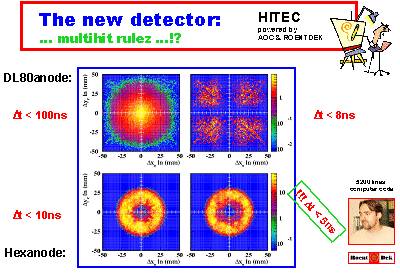
Fig. 3: New kind of delay line anodes for the position readout of Multi Channel Plate (MCP) detectors have been developed in order to reduce multihit deadtime problems (Hexanode). Using three layers instead of two, the spatial distance of two hits on the detector as a function of time difference could be reduced to a circle with 10 mm in diameter. For the common two layer anodes like the DL80 the blind zone has a cross like shape dividing the detector by two perpendicular lines with 10 mm strength (see upper row).
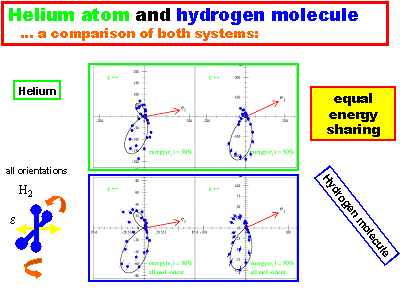
Fig. 4: Even when integrating over all molecular orientations, below an emission an-gle of 45 degree versus the polarization vector of electron 1, the polar angular distri-bution of electron 2 show distinct differences in comparison to helium. For the case of 25 degree one can see contributions along the blue and red lines (lower row on the right) representing the nodes in case of helium. Increasing the angle of electron 1 versus the polarization vector these contributions vanish (not shown here). In order to survey the influence of the molecular orientation, for 25 degree the distribution is split into three scenarios showing the results for hydrogen aligned parallel and perpen-dicular to the polarization vector.
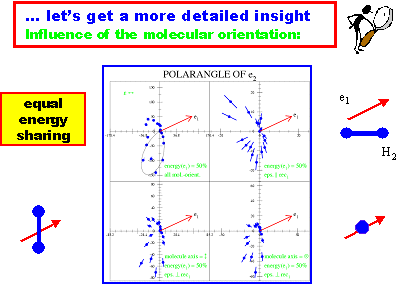
Fig. 5: While discerning the different molecular orientations one can see that the alignment of the polarization vector and the internuclear axis in parallel results in much more contribution along the nodal axis (blue and red dashed lines on the right) in proportion to the interval of polar angles allowed in the case of helium. You see the emitted polar angle distribution of the second electron e2 (points) while the first elec-tron e1 is fixed (arrows; the length of the arrows do not represent any restriction for the electron momentum for e1). Both electrons have the same amount of kinetic en-ergy (Ekin(e1) = Ekin(e2)). Left above: Integrated over all orientations of the mole-cule. On the right above: The molecule axis is parallel to e1. At the bottom left hand corner: The molecule axis is perpendicularly to e1 and is parallel to the paper plane. Down on the right: The molecular axis is perpendicularly to e1 and points out of the plane.
In order to get an overview it is also instructive to take a look at the movie (movie7120.gif). Here the first electron is fixed (red arrow) and the molecule (green bar-bell) rotates in the paper plane. The dotted red line and the solid blue line again represent the nodal axis. The curves you see in the figures are simple fits for helium-data (dashed black line). The second curves in the movies are made by >simple the-ory<: It's taken out of: J. Feagin, JPB: At. Mol. Opt., 32 ,(1999) 2473-2486: There the D2 is described by two helium atoms, which result in different matrix elements for different orientations of the internuclear axis in respect to the polarization vector.
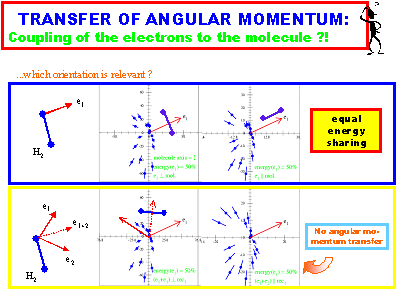
Fig. 6: The photo double ionization of hydrogen results in four free particles in the final state. Which coordinates are relevant to discover the interaction between the electrons and the protons ? The distributions are sensitive to angular momentum transfer (see figure to the left - the lower row is generated by using Jacobi coordi-nates).
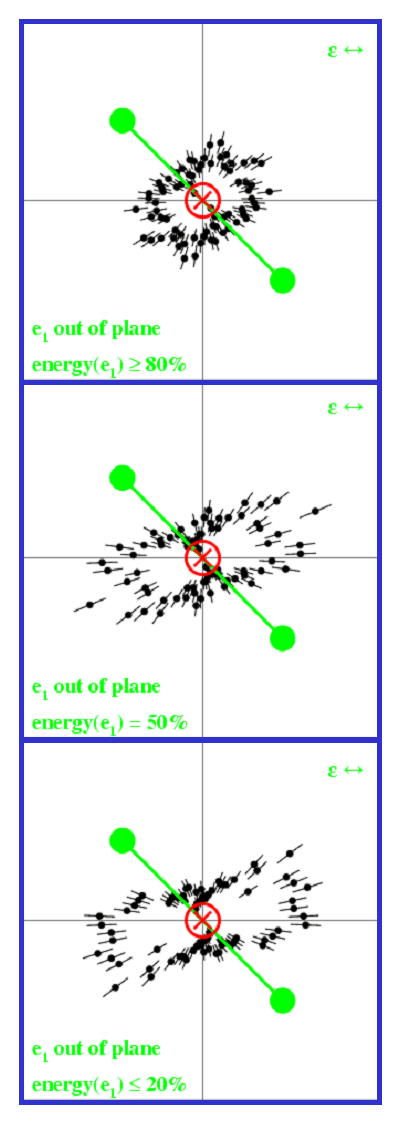
Fig. 7: Forcing the second electron to be emitted in the molecular plane, defined by the inter-nuclear axis and the polarization vector, one can probe the molecule. Elec-tron-electron "correlation" has been switched off by orientating the first electron rec-tangular to the molecular plane. While varying the energy sharing of the electrons the distribution changes due to angular momentum transfer and the influence of the po-larization. In the movies the energy sharing is fixed and the molecule is rotating (see movie8900.gif, movie8910.gif and movie8920.gif).
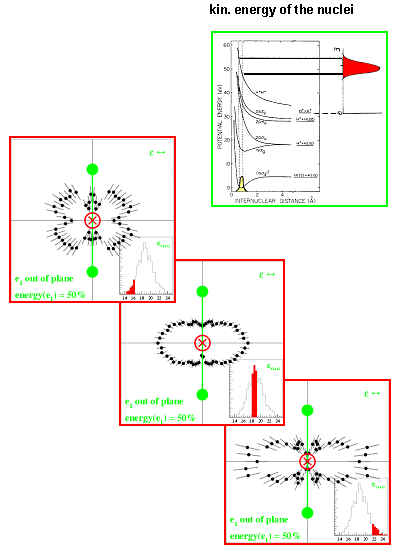
Fig. 8: In the energy spectrum the repulsive curve of the H++H+state maps directly the initial state into the continuum. Going vice versa is shown below:
Scanning the sum energy of the ions (e.g. the coulomb explosion; see the inset in the figures to the right), one even can probe vibrational states of the hydrogen molecule at the time of photo-ionization: In terms of Legendre Polynoms, for the case aligning the molecule perpendicular to the polarization vector, one can see the angular distri-bution of electron 2 changing from d- to f like shape (see also movie18900.gif for a better overview). This scenario shows a different evolution for unequal energy shar-ing (not shown here).
Downloads:
The full story is also available as a talk and a poster !
Part of the story can be found in this paper:
Th. Weber et al., PRL 92(2004)163001-1 (PDF 222 kB, ZIP 208 kB)
|
|







